Warehouse and Inventory
VerifiedAdded on 2023/01/19
|7
|1558
|39
AI Summary
This document discusses how IKEA Group expresses its solidarity with sustainability in warehouses and their adherence to IWAY standards. It also elaborates on IKEA's inventory management policy and the three pillars of inventory management plan. Additionally, it provides insights on how to reduce inventory for a certain component in IKEA and the efficacy of Warehouse Management System (WMS) in IKEA.
Contribute Materials
Your contribution can guide someone’s learning journey. Share your
documents today.
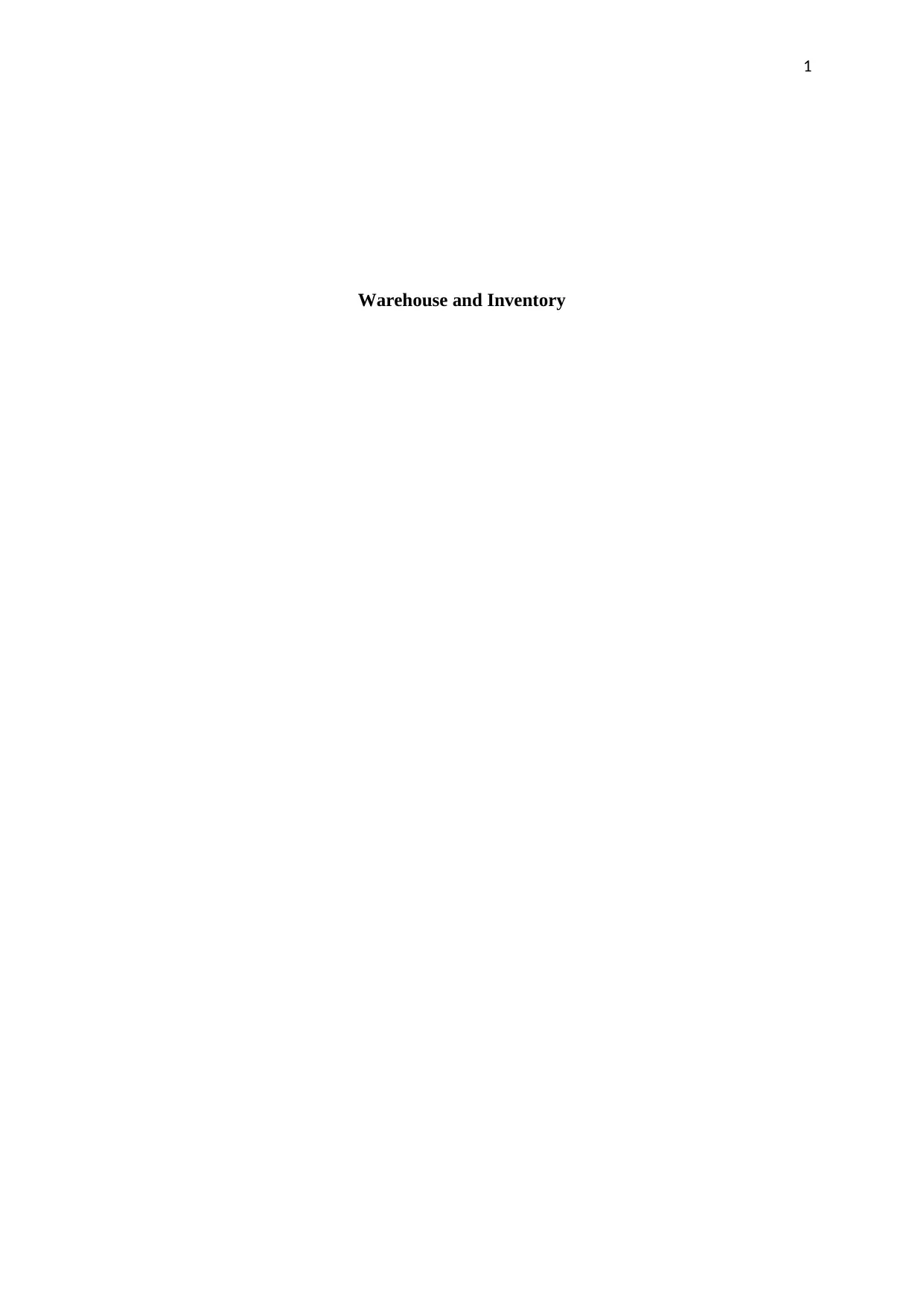
1
Warehouse and Inventory
Warehouse and Inventory
Secure Best Marks with AI Grader
Need help grading? Try our AI Grader for instant feedback on your assignments.
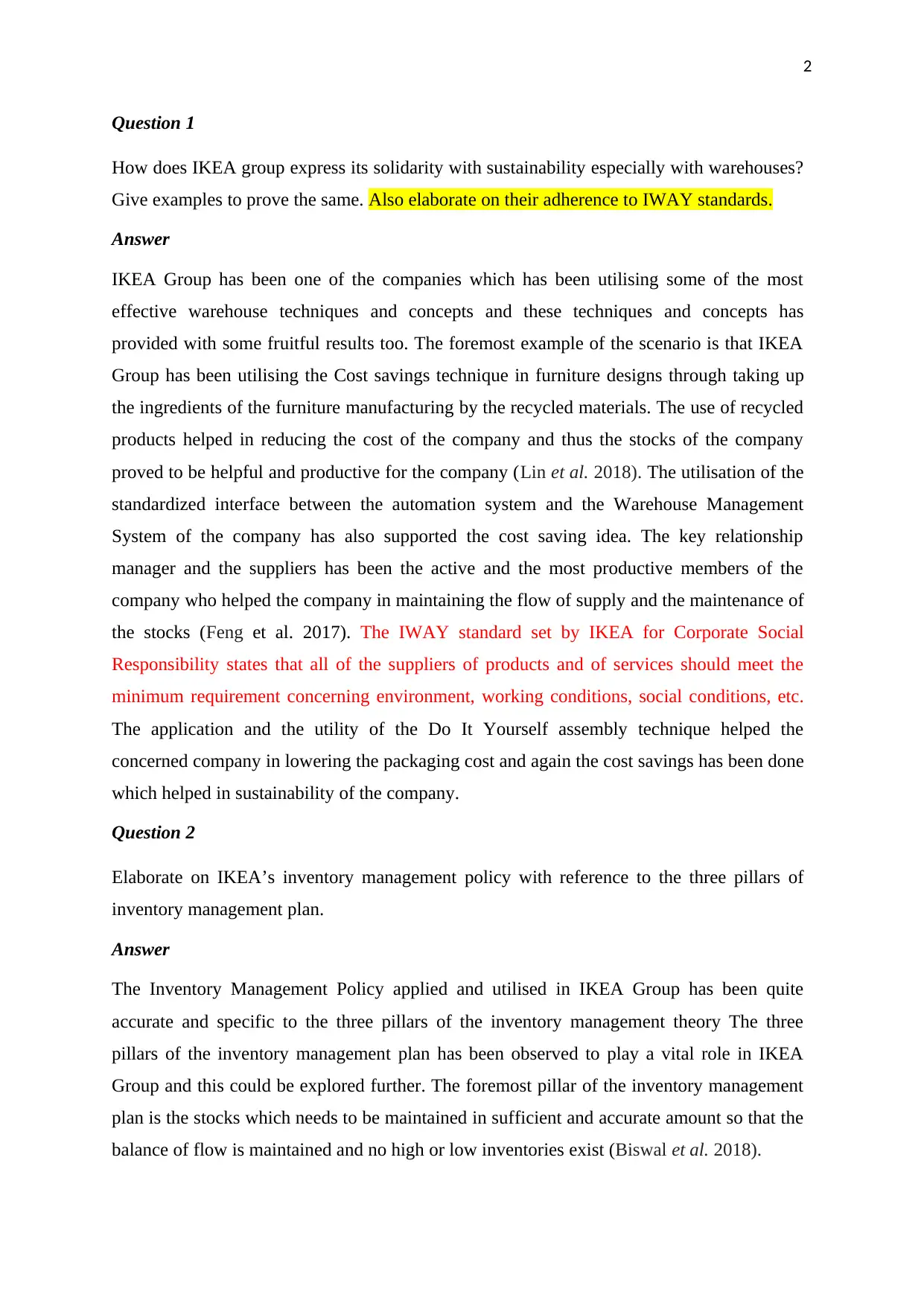
2
Question 1
How does IKEA group express its solidarity with sustainability especially with warehouses?
Give examples to prove the same. Also elaborate on their adherence to IWAY standards.
Answer
IKEA Group has been one of the companies which has been utilising some of the most
effective warehouse techniques and concepts and these techniques and concepts has
provided with some fruitful results too. The foremost example of the scenario is that IKEA
Group has been utilising the Cost savings technique in furniture designs through taking up
the ingredients of the furniture manufacturing by the recycled materials. The use of recycled
products helped in reducing the cost of the company and thus the stocks of the company
proved to be helpful and productive for the company (Lin et al. 2018). The utilisation of the
standardized interface between the automation system and the Warehouse Management
System of the company has also supported the cost saving idea. The key relationship
manager and the suppliers has been the active and the most productive members of the
company who helped the company in maintaining the flow of supply and the maintenance of
the stocks (Feng et al. 2017). The IWAY standard set by IKEA for Corporate Social
Responsibility states that all of the suppliers of products and of services should meet the
minimum requirement concerning environment, working conditions, social conditions, etc.
The application and the utility of the Do It Yourself assembly technique helped the
concerned company in lowering the packaging cost and again the cost savings has been done
which helped in sustainability of the company.
Question 2
Elaborate on IKEA’s inventory management policy with reference to the three pillars of
inventory management plan.
Answer
The Inventory Management Policy applied and utilised in IKEA Group has been quite
accurate and specific to the three pillars of the inventory management theory The three
pillars of the inventory management plan has been observed to play a vital role in IKEA
Group and this could be explored further. The foremost pillar of the inventory management
plan is the stocks which needs to be maintained in sufficient and accurate amount so that the
balance of flow is maintained and no high or low inventories exist (Biswal et al. 2018).
Question 1
How does IKEA group express its solidarity with sustainability especially with warehouses?
Give examples to prove the same. Also elaborate on their adherence to IWAY standards.
Answer
IKEA Group has been one of the companies which has been utilising some of the most
effective warehouse techniques and concepts and these techniques and concepts has
provided with some fruitful results too. The foremost example of the scenario is that IKEA
Group has been utilising the Cost savings technique in furniture designs through taking up
the ingredients of the furniture manufacturing by the recycled materials. The use of recycled
products helped in reducing the cost of the company and thus the stocks of the company
proved to be helpful and productive for the company (Lin et al. 2018). The utilisation of the
standardized interface between the automation system and the Warehouse Management
System of the company has also supported the cost saving idea. The key relationship
manager and the suppliers has been the active and the most productive members of the
company who helped the company in maintaining the flow of supply and the maintenance of
the stocks (Feng et al. 2017). The IWAY standard set by IKEA for Corporate Social
Responsibility states that all of the suppliers of products and of services should meet the
minimum requirement concerning environment, working conditions, social conditions, etc.
The application and the utility of the Do It Yourself assembly technique helped the
concerned company in lowering the packaging cost and again the cost savings has been done
which helped in sustainability of the company.
Question 2
Elaborate on IKEA’s inventory management policy with reference to the three pillars of
inventory management plan.
Answer
The Inventory Management Policy applied and utilised in IKEA Group has been quite
accurate and specific to the three pillars of the inventory management theory The three
pillars of the inventory management plan has been observed to play a vital role in IKEA
Group and this could be explored further. The foremost pillar of the inventory management
plan is the stocks which needs to be maintained in sufficient and accurate amount so that the
balance of flow is maintained and no high or low inventories exist (Biswal et al. 2018).
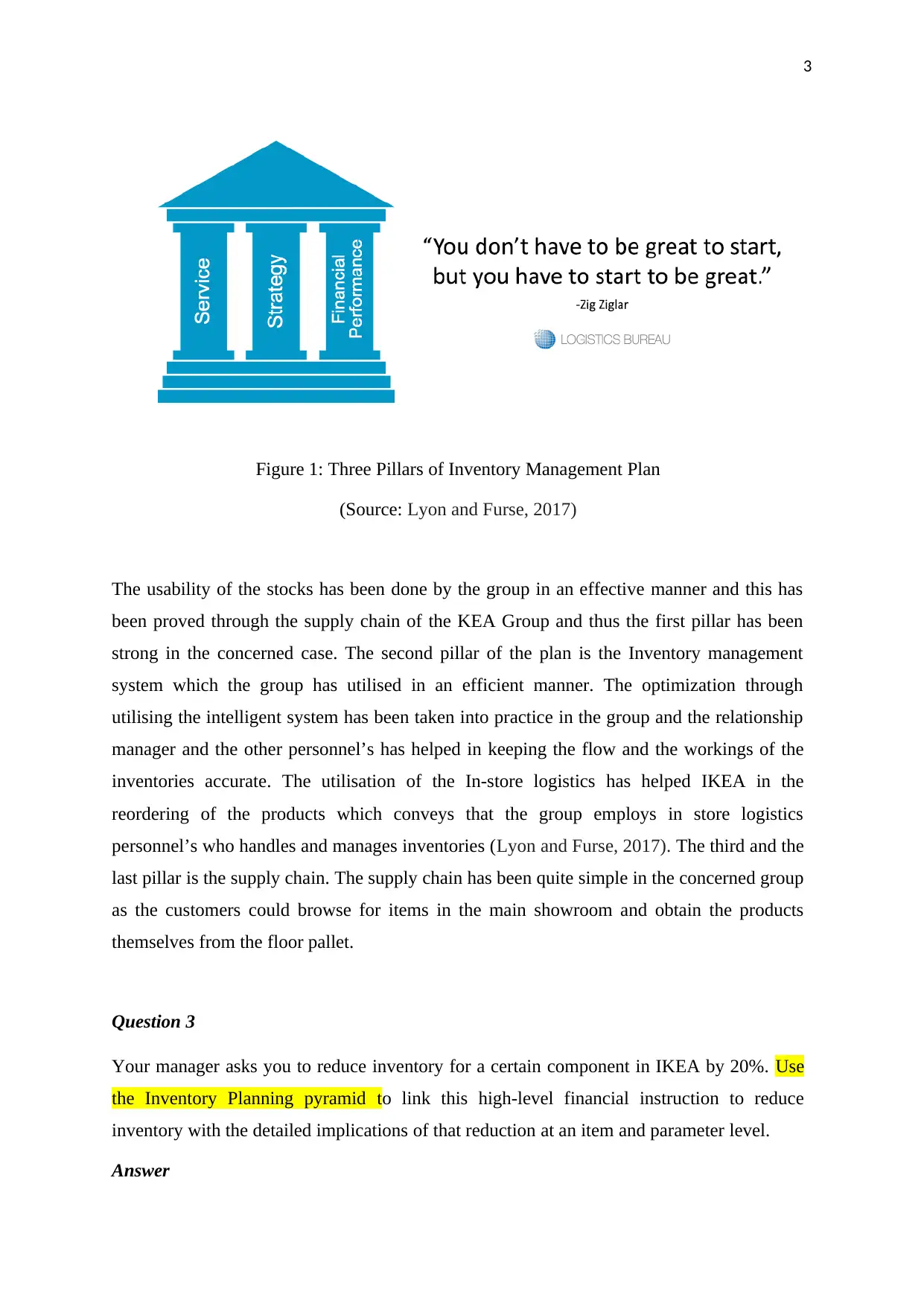
3
Figure 1: Three Pillars of Inventory Management Plan
(Source: Lyon and Furse, 2017)
The usability of the stocks has been done by the group in an effective manner and this has
been proved through the supply chain of the KEA Group and thus the first pillar has been
strong in the concerned case. The second pillar of the plan is the Inventory management
system which the group has utilised in an efficient manner. The optimization through
utilising the intelligent system has been taken into practice in the group and the relationship
manager and the other personnel’s has helped in keeping the flow and the workings of the
inventories accurate. The utilisation of the In-store logistics has helped IKEA in the
reordering of the products which conveys that the group employs in store logistics
personnel’s who handles and manages inventories (Lyon and Furse, 2017). The third and the
last pillar is the supply chain. The supply chain has been quite simple in the concerned group
as the customers could browse for items in the main showroom and obtain the products
themselves from the floor pallet.
Question 3
Your manager asks you to reduce inventory for a certain component in IKEA by 20%. Use
the Inventory Planning pyramid to link this high-level financial instruction to reduce
inventory with the detailed implications of that reduction at an item and parameter level.
Answer
Figure 1: Three Pillars of Inventory Management Plan
(Source: Lyon and Furse, 2017)
The usability of the stocks has been done by the group in an effective manner and this has
been proved through the supply chain of the KEA Group and thus the first pillar has been
strong in the concerned case. The second pillar of the plan is the Inventory management
system which the group has utilised in an efficient manner. The optimization through
utilising the intelligent system has been taken into practice in the group and the relationship
manager and the other personnel’s has helped in keeping the flow and the workings of the
inventories accurate. The utilisation of the In-store logistics has helped IKEA in the
reordering of the products which conveys that the group employs in store logistics
personnel’s who handles and manages inventories (Lyon and Furse, 2017). The third and the
last pillar is the supply chain. The supply chain has been quite simple in the concerned group
as the customers could browse for items in the main showroom and obtain the products
themselves from the floor pallet.
Question 3
Your manager asks you to reduce inventory for a certain component in IKEA by 20%. Use
the Inventory Planning pyramid to link this high-level financial instruction to reduce
inventory with the detailed implications of that reduction at an item and parameter level.
Answer
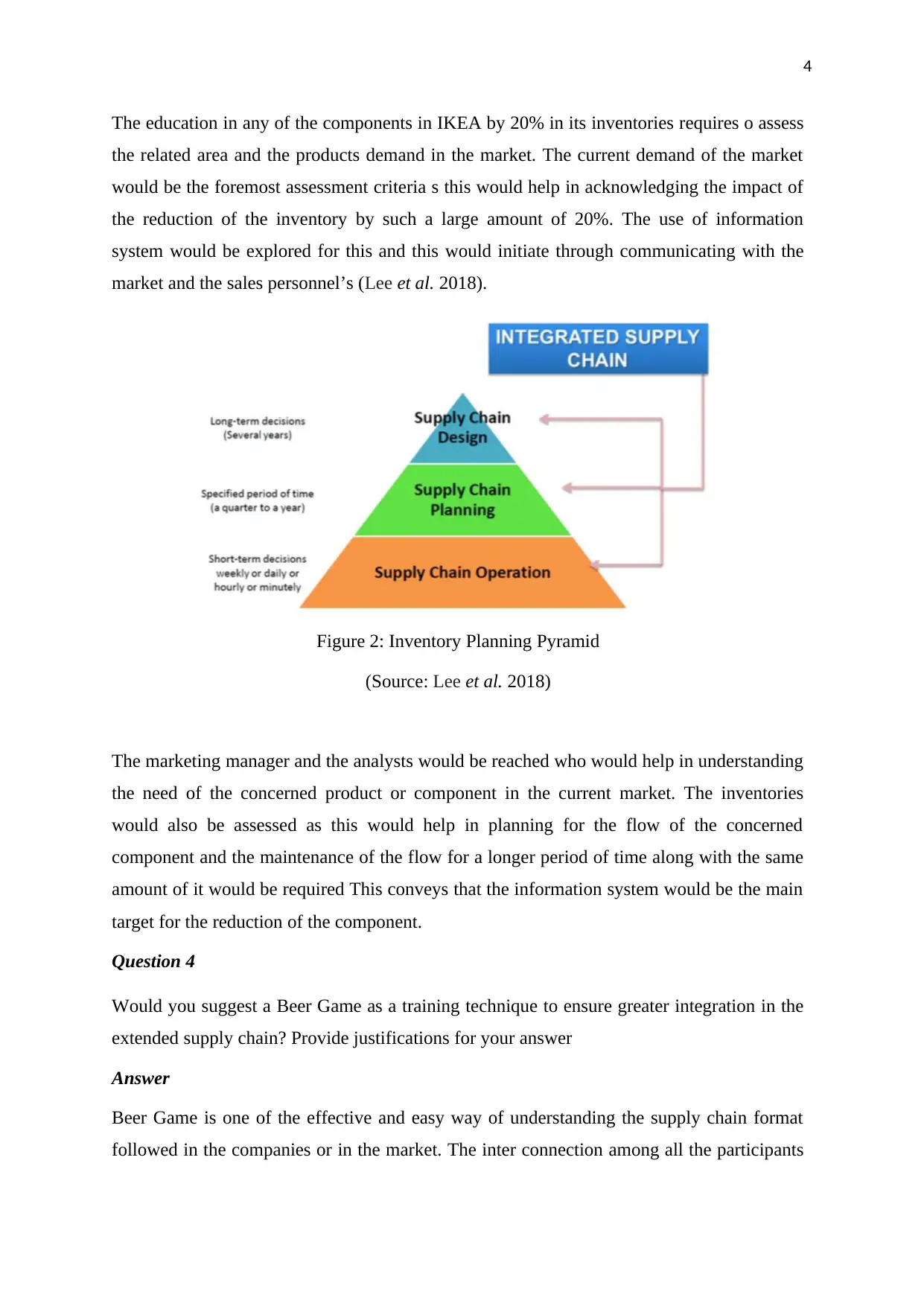
4
The education in any of the components in IKEA by 20% in its inventories requires o assess
the related area and the products demand in the market. The current demand of the market
would be the foremost assessment criteria s this would help in acknowledging the impact of
the reduction of the inventory by such a large amount of 20%. The use of information
system would be explored for this and this would initiate through communicating with the
market and the sales personnel’s (Lee et al. 2018).
Figure 2: Inventory Planning Pyramid
(Source: Lee et al. 2018)
The marketing manager and the analysts would be reached who would help in understanding
the need of the concerned product or component in the current market. The inventories
would also be assessed as this would help in planning for the flow of the concerned
component and the maintenance of the flow for a longer period of time along with the same
amount of it would be required This conveys that the information system would be the main
target for the reduction of the component.
Question 4
Would you suggest a Beer Game as a training technique to ensure greater integration in the
extended supply chain? Provide justifications for your answer
Answer
Beer Game is one of the effective and easy way of understanding the supply chain format
followed in the companies or in the market. The inter connection among all the participants
The education in any of the components in IKEA by 20% in its inventories requires o assess
the related area and the products demand in the market. The current demand of the market
would be the foremost assessment criteria s this would help in acknowledging the impact of
the reduction of the inventory by such a large amount of 20%. The use of information
system would be explored for this and this would initiate through communicating with the
market and the sales personnel’s (Lee et al. 2018).
Figure 2: Inventory Planning Pyramid
(Source: Lee et al. 2018)
The marketing manager and the analysts would be reached who would help in understanding
the need of the concerned product or component in the current market. The inventories
would also be assessed as this would help in planning for the flow of the concerned
component and the maintenance of the flow for a longer period of time along with the same
amount of it would be required This conveys that the information system would be the main
target for the reduction of the component.
Question 4
Would you suggest a Beer Game as a training technique to ensure greater integration in the
extended supply chain? Provide justifications for your answer
Answer
Beer Game is one of the effective and easy way of understanding the supply chain format
followed in the companies or in the market. The inter connection among all the participants
Secure Best Marks with AI Grader
Need help grading? Try our AI Grader for instant feedback on your assignments.
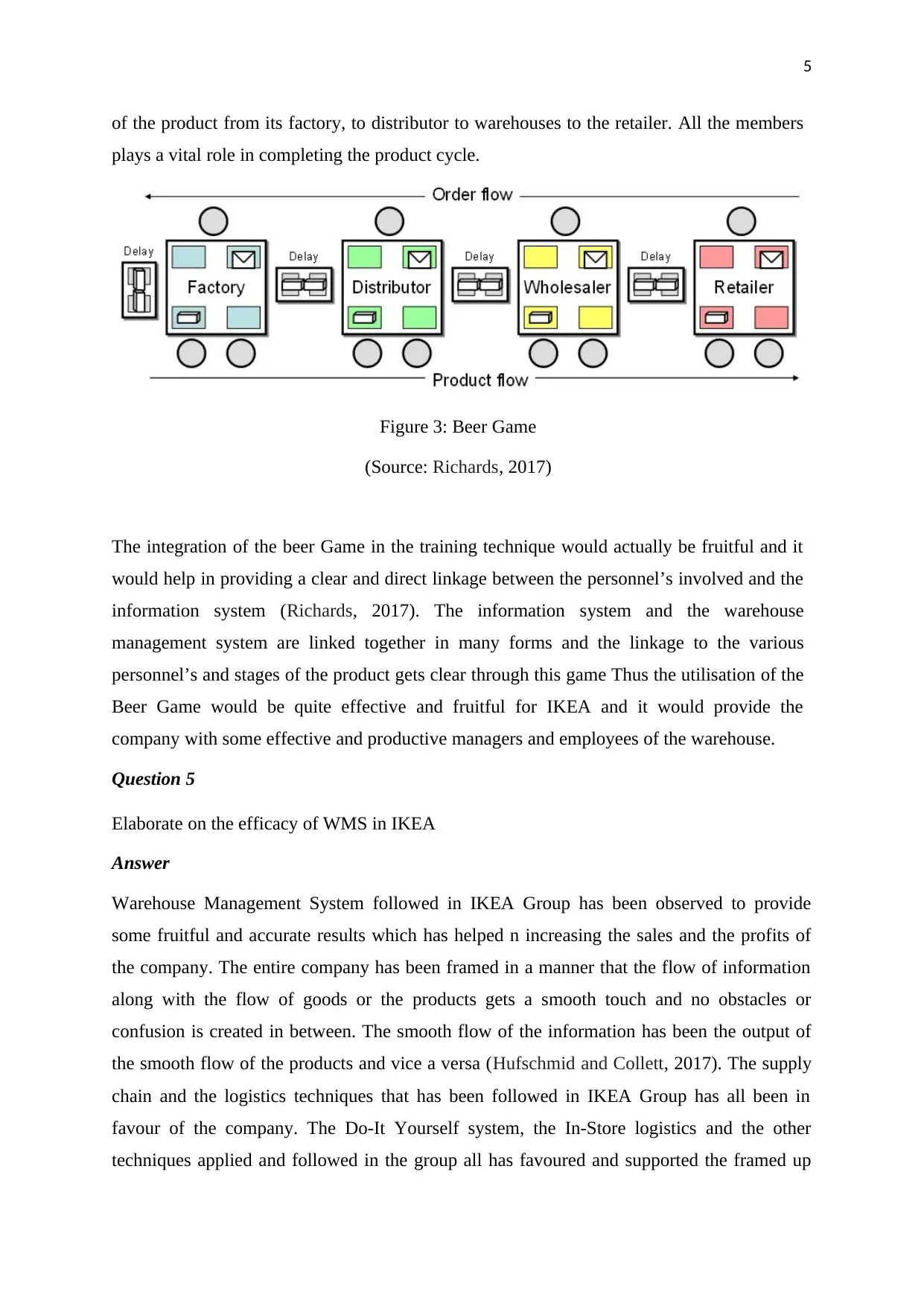
5
of the product from its factory, to distributor to warehouses to the retailer. All the members
plays a vital role in completing the product cycle.
Figure 3: Beer Game
(Source: Richards, 2017)
The integration of the beer Game in the training technique would actually be fruitful and it
would help in providing a clear and direct linkage between the personnel’s involved and the
information system (Richards, 2017). The information system and the warehouse
management system are linked together in many forms and the linkage to the various
personnel’s and stages of the product gets clear through this game Thus the utilisation of the
Beer Game would be quite effective and fruitful for IKEA and it would provide the
company with some effective and productive managers and employees of the warehouse.
Question 5
Elaborate on the efficacy of WMS in IKEA
Answer
Warehouse Management System followed in IKEA Group has been observed to provide
some fruitful and accurate results which has helped n increasing the sales and the profits of
the company. The entire company has been framed in a manner that the flow of information
along with the flow of goods or the products gets a smooth touch and no obstacles or
confusion is created in between. The smooth flow of the information has been the output of
the smooth flow of the products and vice a versa (Hufschmid and Collett, 2017). The supply
chain and the logistics techniques that has been followed in IKEA Group has all been in
favour of the company. The Do-It Yourself system, the In-Store logistics and the other
techniques applied and followed in the group all has favoured and supported the framed up
of the product from its factory, to distributor to warehouses to the retailer. All the members
plays a vital role in completing the product cycle.
Figure 3: Beer Game
(Source: Richards, 2017)
The integration of the beer Game in the training technique would actually be fruitful and it
would help in providing a clear and direct linkage between the personnel’s involved and the
information system (Richards, 2017). The information system and the warehouse
management system are linked together in many forms and the linkage to the various
personnel’s and stages of the product gets clear through this game Thus the utilisation of the
Beer Game would be quite effective and fruitful for IKEA and it would provide the
company with some effective and productive managers and employees of the warehouse.
Question 5
Elaborate on the efficacy of WMS in IKEA
Answer
Warehouse Management System followed in IKEA Group has been observed to provide
some fruitful and accurate results which has helped n increasing the sales and the profits of
the company. The entire company has been framed in a manner that the flow of information
along with the flow of goods or the products gets a smooth touch and no obstacles or
confusion is created in between. The smooth flow of the information has been the output of
the smooth flow of the products and vice a versa (Hufschmid and Collett, 2017). The supply
chain and the logistics techniques that has been followed in IKEA Group has all been in
favour of the company. The Do-It Yourself system, the In-Store logistics and the other
techniques applied and followed in the group all has favoured and supported the framed up
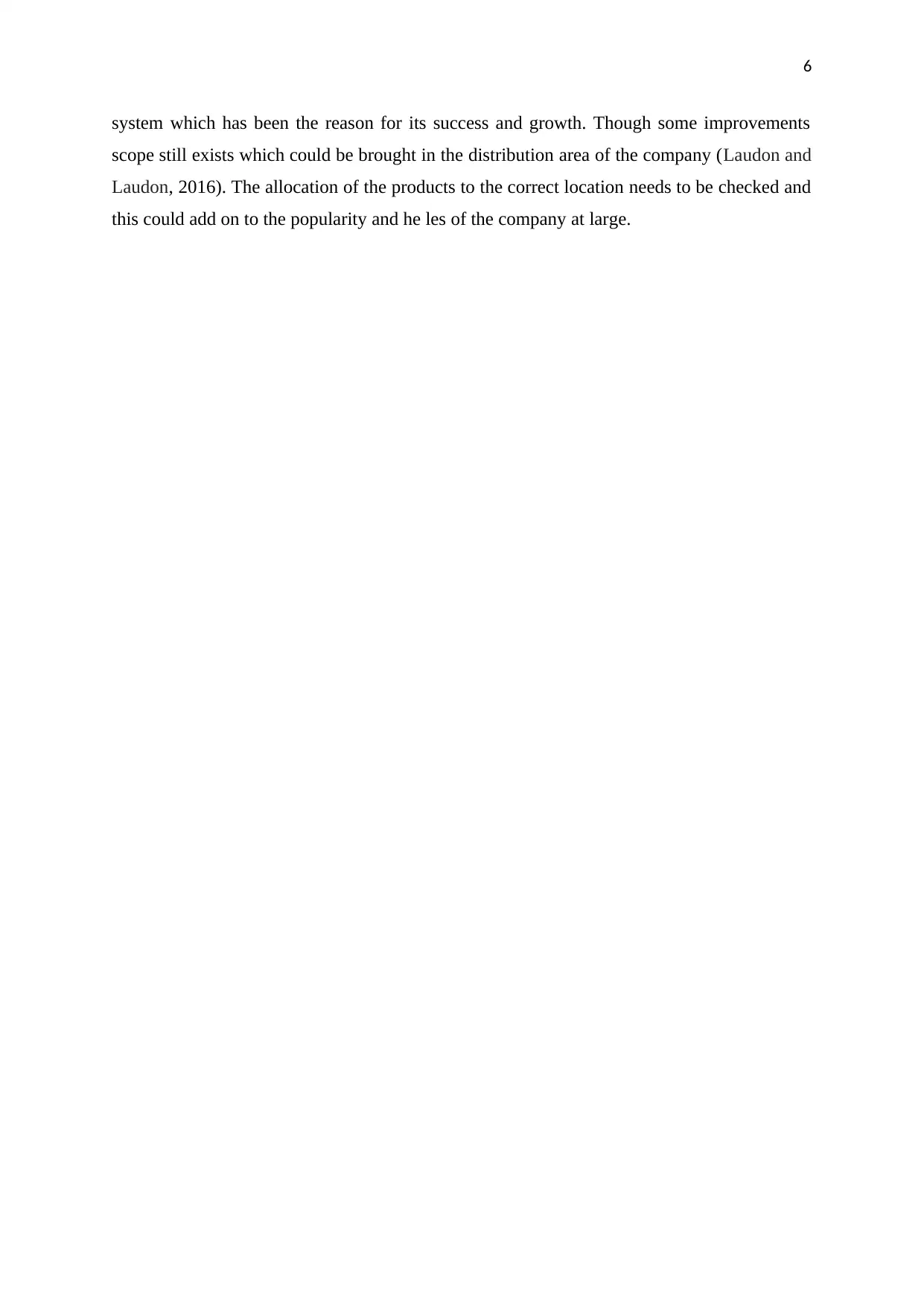
6
system which has been the reason for its success and growth. Though some improvements
scope still exists which could be brought in the distribution area of the company (Laudon and
Laudon, 2016). The allocation of the products to the correct location needs to be checked and
this could add on to the popularity and he les of the company at large.
system which has been the reason for its success and growth. Though some improvements
scope still exists which could be brought in the distribution area of the company (Laudon and
Laudon, 2016). The allocation of the products to the correct location needs to be checked and
this could add on to the popularity and he les of the company at large.
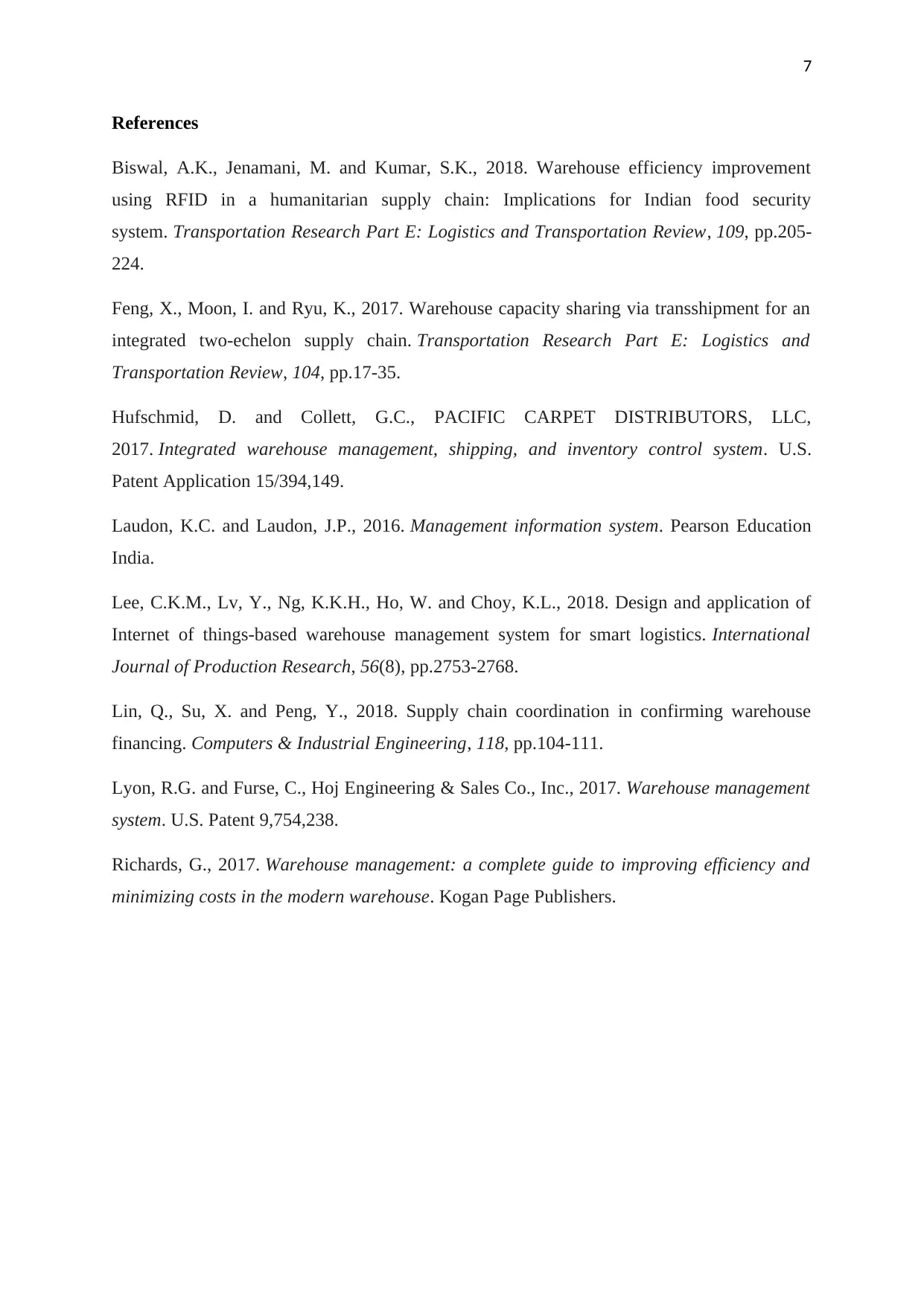
7
References
Biswal, A.K., Jenamani, M. and Kumar, S.K., 2018. Warehouse efficiency improvement
using RFID in a humanitarian supply chain: Implications for Indian food security
system. Transportation Research Part E: Logistics and Transportation Review, 109, pp.205-
224.
Feng, X., Moon, I. and Ryu, K., 2017. Warehouse capacity sharing via transshipment for an
integrated two-echelon supply chain. Transportation Research Part E: Logistics and
Transportation Review, 104, pp.17-35.
Hufschmid, D. and Collett, G.C., PACIFIC CARPET DISTRIBUTORS, LLC,
2017. Integrated warehouse management, shipping, and inventory control system. U.S.
Patent Application 15/394,149.
Laudon, K.C. and Laudon, J.P., 2016. Management information system. Pearson Education
India.
Lee, C.K.M., Lv, Y., Ng, K.K.H., Ho, W. and Choy, K.L., 2018. Design and application of
Internet of things-based warehouse management system for smart logistics. International
Journal of Production Research, 56(8), pp.2753-2768.
Lin, Q., Su, X. and Peng, Y., 2018. Supply chain coordination in confirming warehouse
financing. Computers & Industrial Engineering, 118, pp.104-111.
Lyon, R.G. and Furse, C., Hoj Engineering & Sales Co., Inc., 2017. Warehouse management
system. U.S. Patent 9,754,238.
Richards, G., 2017. Warehouse management: a complete guide to improving efficiency and
minimizing costs in the modern warehouse. Kogan Page Publishers.
References
Biswal, A.K., Jenamani, M. and Kumar, S.K., 2018. Warehouse efficiency improvement
using RFID in a humanitarian supply chain: Implications for Indian food security
system. Transportation Research Part E: Logistics and Transportation Review, 109, pp.205-
224.
Feng, X., Moon, I. and Ryu, K., 2017. Warehouse capacity sharing via transshipment for an
integrated two-echelon supply chain. Transportation Research Part E: Logistics and
Transportation Review, 104, pp.17-35.
Hufschmid, D. and Collett, G.C., PACIFIC CARPET DISTRIBUTORS, LLC,
2017. Integrated warehouse management, shipping, and inventory control system. U.S.
Patent Application 15/394,149.
Laudon, K.C. and Laudon, J.P., 2016. Management information system. Pearson Education
India.
Lee, C.K.M., Lv, Y., Ng, K.K.H., Ho, W. and Choy, K.L., 2018. Design and application of
Internet of things-based warehouse management system for smart logistics. International
Journal of Production Research, 56(8), pp.2753-2768.
Lin, Q., Su, X. and Peng, Y., 2018. Supply chain coordination in confirming warehouse
financing. Computers & Industrial Engineering, 118, pp.104-111.
Lyon, R.G. and Furse, C., Hoj Engineering & Sales Co., Inc., 2017. Warehouse management
system. U.S. Patent 9,754,238.
Richards, G., 2017. Warehouse management: a complete guide to improving efficiency and
minimizing costs in the modern warehouse. Kogan Page Publishers.
1 out of 7
Related Documents
Your All-in-One AI-Powered Toolkit for Academic Success.
+13062052269
info@desklib.com
Available 24*7 on WhatsApp / Email
![[object Object]](/_next/static/media/star-bottom.7253800d.svg)
Unlock your academic potential
© 2024 | Zucol Services PVT LTD | All rights reserved.




